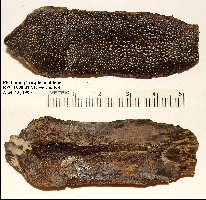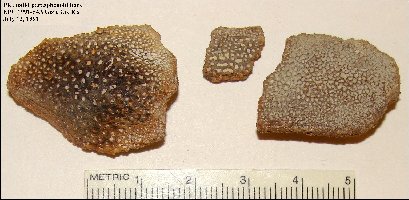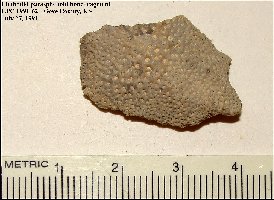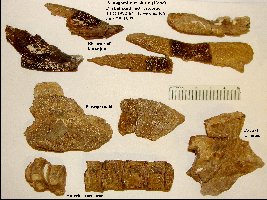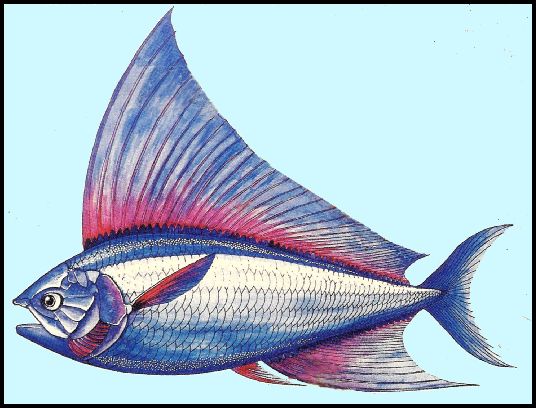 |
Pentanogmius (Bananogmius)
evolutus
Copyright © 2007-2012 by Mike Everhart
Page created 05/29/2007 - Updated
05/21/2012
LEFT: Painting of Pentanogmius evolutus
adapted from an original work (Plate 30) by Deb Bennett (1983) as published in Kansas
Geology, Rex Buchanan (ed.), University of Kansas Press, 1983.
|
Pentanogmius (Bananogmius) evolutus is featured in the National
Geographic IMAX movie, Sea Monsters CLICK
HERE
Pentanogmius evolutus (Cope) is one a diverse family of
plethodids from the Western Interior Sea ( Late Cretaceous) of Kansas. The remains of plethodids are a fairly
common in the Smoky Hill Chalk. The family Plethodidae includes the genera: Pentanogmius (originally "Anogmius" evolutus, then Bananogmius), Ferrifrons,
Niobrara, Zanclites, Luxilites, Syntegmodus, Bananogmius, Martinichthys, Thryptodus,
and Plethodus. The species "Bananogmius evolutus" was removed from the genus Bananogmius
and renamed Pentanogmius evolutus by Taverne (2001).
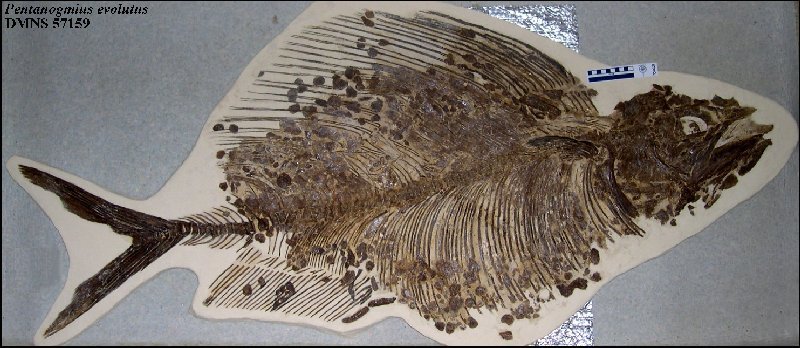 |
Pentanogmius was a medium to large sized fish (4 to 6+ feet) with
a narrow, but deep body (somewhat like a modern
Angel fish) and jaws that had small, comb-like
teeth. Most of the skeleton was bone and preserves well. A commonly found fossil is
the palatine bone from the roof of the mouth. These have a pebbled surface that served as
the base for hundreds of small, sharp teeth.
E.D.
Cope originally named the genus "Anogmius" in 1877, but that genus name
had already been used (e.g. pre-occupied).
LEFT:
DMNS 57159 - A large and nearly complete Pentanogmius evolutus (Cope)
in the Denver Museum that was discovered
by Chuck Bonner near Monument Rocks in the Smoky Hill Chalk of western Kansas. The tail is reconstructed. |
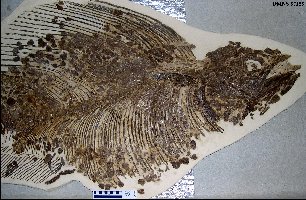 |
LEFT: DMNS 57159 is probably the best preserved, most complete
example known of Pentanogmius evolutus. Shown here in right lateral view. See more photos on the
Keystone Gallery site RIGHT: The skull of DMNS 57159 in right
lateral view. |
 |
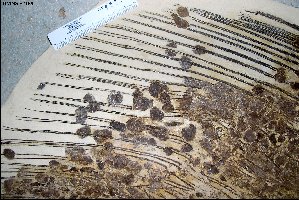 |
LEFT: A close up of the dorsal fin (sail) of DMNS 57159,
showing some of the scales preserved with the specimen.
RIGHT: A close-up of the jaws of DMNS 57159 showing the hundreds of tiny teeth
that covered the jaw plates. |
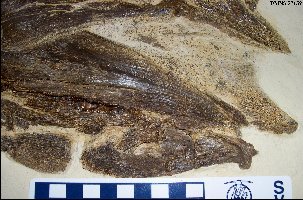 |
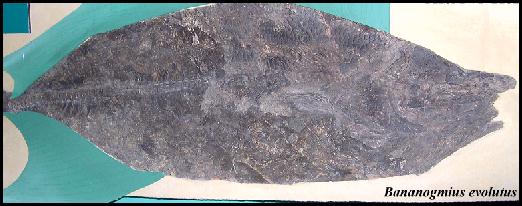
|
LEFT:
The exhibit specimen of Bananogmius (Pentanogmius) evolutus (FHSM
VP-2182) in the collection of the Sternberg Museum. Although not fully displayed in this
photograph of the reconstruction, the fish had a large, sail-like dorsal fin. Detail of the anterior portion of the
specimen, including scales is shown here. |
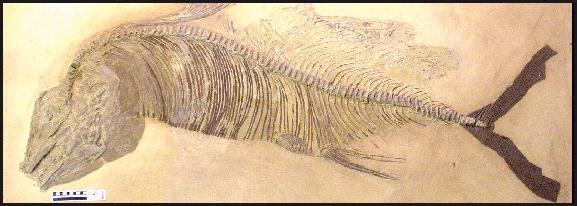
|
LEFT:
Bananogmius (Pentanogmius) evolutus FHSM VP-2117) from the
Smoky Hill Chalk in the collection of the Sternberg Museum of Natural History. Collected
by Marion Bonner. The caudal fin (tail) is reconstructed. A close up view of the skull is HERE. A view of the teeth on the lower jaw
of another specimen is HERE. |
 |
LEFT: The oddly crushed skull of FHSM VP-2117. RIGHT:
Close-up of one of the tooth bearing elements (left lower jaw?) of FHSM VP-2117 (note that
teeth are missing). |
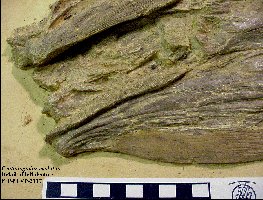 |
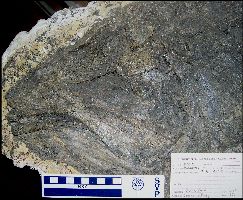 |
LEFT: The skull of a large Bananogmius
(Pentanogmius?) evolutus - KUVP 27815 in left lateral view collected from
the Pierre Shale in 1971 by the Orville Bonner party. RIGHT: The type specimen of Bananogmius ellisensis, preserved
uncrushed in an ironstone concretion from the Blue Hill Shale Member of the Carlile Shale,
Ellis County, Kansas (Middle Turonian in age). |
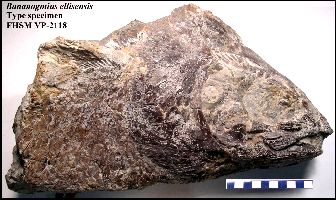 |
 |
LEFT: KUVP 445 - Right lateral view of a large Bananogmius
(Pentanogmius?) specimen collected from a concretion in the Fairport Chalk Member
(Middle Turonian) of the Carlile Shale, Russell County, KS. A detailed view of the skull is here. |
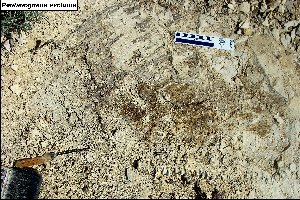 |
The most recent discovery (2012) of a reasonably complete
specimen of Pentanogmius evolutus was made in the upper chalk of
western Logan County by Fred Ackerman. Unfortunately the held of the fish
was already eroded out and mostly destroyed, and the tail was missing. The
specimen would have measured almost 4 feet long if complete and the dorsal
fin (sail) extended 20 inches above the vertebral column.
LEFT: Headless and tailless, the specimen preserves a nearly
complete dorsal fin.
RIGHT: This close-up of the dorsal fin shows two large scales
(circled). |
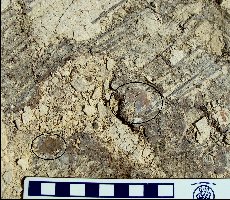 |
Plethodid
fossils: The most common plethodid fossils collected in the Smoky Hill
Chalk are the parasphenoid bones... a flat, roughly rectangular bone on the roof
of the mouth that is has hundreds of small pits.... These pits held small teeth
when the fish was alive.
Other
Oceans of Kansas webpages on Late Cretaceous fish:
Field Guide to Sharks and Bony
Fish of the Smoky Hill Chalk
Sharks:
Kansas Shark Teeth
Cretoxyrhina and Squalicorax
Ptychodus
Chimaeroids
Bony Fish
Pycnodonts and Hadrodus
Plethodids:
Pentanogmius
Martinichthys
Thryptodus
Bonnerichthys
Protosphyraena
Enchodus
Cimolichthys
Pachyrhizodus
Saurodon and Saurocephalus
Xiphactinus
Suggested references:
Cope, E. D. 1877. On some new or little known
reptiles and fishes of the Cretaceous No. 3 of Kansas. Proceedings of the American
Philosophical Society 17(100): 176-181. (Anogmius and Stratodus)
Fielitz, C. and K. Shimada, 1999. A new species of Bananogmius
(Teleostei; Tselfatiformes) from the Upper Cretaceous Carlile Shale of western Kansas.
Journal of Paleontology 73(3): 504-511.
Loomis, F. B. 1900. Die anatomie und die
verwandtschaft der Ganoid- und Knochen-fische aus der Kreide-Formation von Kansas, U.S.A.
Palaeontographica, 46: 213-283.
Taverne, L. 2001. Révision du genre
Bananogmius (Teleostei, Tselfatiiformes), poisson marin du Crétecé
supérior d'Amérique du Nord et d'Europe. Geodiversitas 23(1):17-40. (Revision of the
genus Bananogmius (Teleostei, Tselfatiiformes), marine fish from the Upper
Cretaceous of North America and Europe).
Taverne, L. 2003. Redescription critique des genres Thryptodus, Pseudothryptodus et
Paranogmius, poissons marins (Telostei,
Tselfatiiformes) du Crétecé supérior des Etats-Unis d’ Egypte et de Libye. Belgian Journal of Zoology 133(2):163-173.















